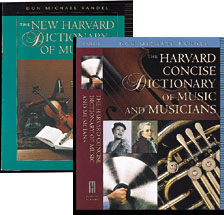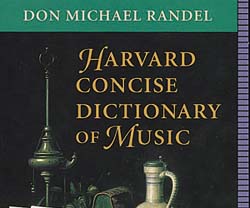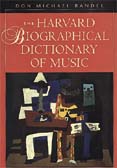Mr.
Randel's Opus
U
of C music professor Anne W. Robertson chronicles Don Michael
Randel's contributions to musicology.
 To
read Don Randel's scholarly work is to taste from a cornucopia
of subjects and methodologies that he has addressed over more
than three decades. Certain threads draw these endeavors together-for
instance, his work on Hispanic and Latin American music, work
that ranges from the earliest notated music on the Iberian Peninsula
to the most recent living traditions in Central and South America.
To
read Don Randel's scholarly work is to taste from a cornucopia
of subjects and methodologies that he has addressed over more
than three decades. Certain threads draw these endeavors together-for
instance, his work on Hispanic and Latin American music, work
that ranges from the earliest notated music on the Iberian Peninsula
to the most recent living traditions in Central and South America.
Influenced in the mid-1960s by his Princeton mentor
Oliver Strunk, a scholar of Byzantine chant, Randel carved out
a field that combined his own interest in medieval plainsong with
his childhood experience living in a Latin American culture. He
wrote on the music of the Mozarabic Rite, a branch of Christian
liturgical chant sung in Spain until the late 11th century. Called
"Mozarabic" because most of the manuscripts preserving this music
date from a time after the Muslim conquest of Spain in 711, this
ritual has left behind two dozen or so sources. None uses a musical
notation that can be deciphered. Instead, one finds musical symbols
(called "neumes") without staff lines, which present graphic,
but vertically undifferentiated, notes on the page. Because we
cannot be certain of exact pitches, we will never know precisely
how the majority of these melodies sound. Randel's Index to
the Chant of the Mozarabic Rite (Princeton, 1973), in grappling
with this limitation, provided the first comprehensive overview
of the entire Mozarabic repertory, showing the variety and richness
of these medieval Spanish melodies. Traces of them can still be
heard in a few churches in Toledo, Salamanca, and Valladolid.
This herculean labor complemented his in-depth study of Mozarabic
psalmody, The Responsorial Psalm Tones for the Mozarabic Office,
based on his original dissertation and published by Princeton
in 1969.
 Beginning
in the 1970s, Randel's work moved forward in time, focusing on
issues of medieval music theory and 15th-century polyphony. Building
on his work on Mozarabic music and adding Arabic to the arsenal
of foreign languages already at his command (fluent in Spanish,
he also has a working knowledge of Italian, French, and German),
he studied how the theoretical writings on music by the Muslim
scientist and philosopher Al-Farabi (d. 950), translated from
Arabic into Latin in the 12th and early 13th centuries, affected
Western music theory. His 1971 article in Musical Quarterly,
"Emerging Triadic Tonality in the Fifteenth Century," was one
of the first to deal with the ways in which musical pitches came
to be combined into the vertical, simultaneous sonorities that
we now call "triads," the basic building blocks of music. His
"Dufay the Reader" (in Music and Language, Studies in Music
History 1, New York, 1983) takes the text as point of departure.
Here Randel examines the words on their own terms: he shows how
the famous early-Renaissance composer Guillaume Dufay (c. 1400-74)
"reads" a poem through his musical setting of it, highlighting
points at which the music enhances the syntactical and sonic aspects
of the poetry, and vice versa.
Beginning
in the 1970s, Randel's work moved forward in time, focusing on
issues of medieval music theory and 15th-century polyphony. Building
on his work on Mozarabic music and adding Arabic to the arsenal
of foreign languages already at his command (fluent in Spanish,
he also has a working knowledge of Italian, French, and German),
he studied how the theoretical writings on music by the Muslim
scientist and philosopher Al-Farabi (d. 950), translated from
Arabic into Latin in the 12th and early 13th centuries, affected
Western music theory. His 1971 article in Musical Quarterly,
"Emerging Triadic Tonality in the Fifteenth Century," was one
of the first to deal with the ways in which musical pitches came
to be combined into the vertical, simultaneous sonorities that
we now call "triads," the basic building blocks of music. His
"Dufay the Reader" (in Music and Language, Studies in Music
History 1, New York, 1983) takes the text as point of departure.
Here Randel examines the words on their own terms: he shows how
the famous early-Renaissance composer Guillaume Dufay (c. 1400-74)
"reads" a poem through his musical setting of it, highlighting
points at which the music enhances the syntactical and sonic aspects
of the poetry, and vice versa.
As the study of music underwent dramatic changes
in the 1980s, Randel added his voice to the debate in his article
"The Canons in the Musicological Toolbox" (in Disciplining
Music: Musicology and Its Canon, ed. Katherine Bergeron and
Philip V. Bohlman, University of Chicago Press, 1992), arguing
for more inclusive canons of musical scholarship which allow newer
attitudes to broaden the traditional working assumptions of musicologists.
Among his recommendations, Randel advocates the study of oral
as well as fully notated traditions. He likewise suggests that
anonymous works of music may have as compelling a story to tell
as those whose composers we can easily identify. In addition,
he promotes the fostering of topics in music scholarship that
would not have been deemed worthy of investigation four or five
decades ago-jazz, popular music, even Italian opera.
 Randel
followed this up with his "Crossing Over with Rubén Blades," one
of the first articles on a living, popular tradition ever published
by the prestigious Journal of the American Musicological Society
(vol. 44 [1991]), a periodical he'd edited from 1972 through 1974.
Here he returns once again to the culture of Latin America to
discuss Blades's song "Decisiones" from his first solo album for
Elektra Records, Buscando America. Randel focuses on Blades's
new type of Latin sound-a sound that differs noticeably from that
of fixtures of Latin popular music such as El Gran Combo de Puerto
Rico. The roots of this sound, as Randel finds, lie not in the
singer's attempt to portray himself as the "cross over" artist
that critics have labeled him, that is, as an artist who appeals
to two different audiences. Rather, for Randel, Blades himself
is crossing over along with his listeners, a Hispanically based
audience and culture that, in recent times, has been infused with
many of the same Anglo influences evident in this song.
Randel
followed this up with his "Crossing Over with Rubén Blades," one
of the first articles on a living, popular tradition ever published
by the prestigious Journal of the American Musicological Society
(vol. 44 [1991]), a periodical he'd edited from 1972 through 1974.
Here he returns once again to the culture of Latin America to
discuss Blades's song "Decisiones" from his first solo album for
Elektra Records, Buscando America. Randel focuses on Blades's
new type of Latin sound-a sound that differs noticeably from that
of fixtures of Latin popular music such as El Gran Combo de Puerto
Rico. The roots of this sound, as Randel finds, lie not in the
singer's attempt to portray himself as the "cross over" artist
that critics have labeled him, that is, as an artist who appeals
to two different audiences. Rather, for Randel, Blades himself
is crossing over along with his listeners, a Hispanically based
audience and culture that, in recent times, has been infused with
many of the same Anglo influences evident in this song.
Most of us have on our bookshelves one or more general
works on music, and Randel's scholarship also encompasses the
editing of these indispensable books for everyday scholarly use.
Until the mid-1980s, the most widely consulted musical dictionary,
The Harvard Dictionary of Music, was still circulating
in the 1969 edition by Willi Apel. When a short version was needed,
Harvard turned to Randel, who edited The Harvard Concise Dictionary
of Music (1978). Asked next by the press to revamp Apel's
volume, Randel totally reconceived the work to take account of
non-Western traditions, of popular music, and of musical instruments
of different cultures. The New Harvard Dictionary of Music
(1986) now serves as the standard, convenient guide to music
for lay readers, students, performers, composers, scholars, and
teachers. To it Randel has recently added The Harvard Biographical
Dictionary of Music (1996) and The Harvard Concise Dictionary
of Music and Musicians (1999).
Anne W. Robertson, the Claire Dux Swift professor
in music and the College, is the author of The Service Books
of the Royal Abbey of Saint-Denis: Images of Ritual and Music
in the Middle Ages (Oxford, 1991).


![]()
 To
read Don Randel's scholarly work is to taste from a cornucopia
of subjects and methodologies that he has addressed over more
than three decades. Certain threads draw these endeavors together-for
instance, his work on Hispanic and Latin American music, work
that ranges from the earliest notated music on the Iberian Peninsula
to the most recent living traditions in Central and South America.
To
read Don Randel's scholarly work is to taste from a cornucopia
of subjects and methodologies that he has addressed over more
than three decades. Certain threads draw these endeavors together-for
instance, his work on Hispanic and Latin American music, work
that ranges from the earliest notated music on the Iberian Peninsula
to the most recent living traditions in Central and South America. Beginning
in the 1970s, Randel's work moved forward in time, focusing on
issues of medieval music theory and 15th-century polyphony. Building
on his work on Mozarabic music and adding Arabic to the arsenal
of foreign languages already at his command (fluent in Spanish,
he also has a working knowledge of Italian, French, and German),
he studied how the theoretical writings on music by the Muslim
scientist and philosopher Al-Farabi (d. 950), translated from
Arabic into Latin in the 12th and early 13th centuries, affected
Western music theory. His 1971 article in Musical Quarterly,
"Emerging Triadic Tonality in the Fifteenth Century," was one
of the first to deal with the ways in which musical pitches came
to be combined into the vertical, simultaneous sonorities that
we now call "triads," the basic building blocks of music. His
"Dufay the Reader" (in Music and Language, Studies in Music
History 1, New York, 1983) takes the text as point of departure.
Here Randel examines the words on their own terms: he shows how
the famous early-Renaissance composer Guillaume Dufay (c. 1400-74)
"reads" a poem through his musical setting of it, highlighting
points at which the music enhances the syntactical and sonic aspects
of the poetry, and vice versa.
Beginning
in the 1970s, Randel's work moved forward in time, focusing on
issues of medieval music theory and 15th-century polyphony. Building
on his work on Mozarabic music and adding Arabic to the arsenal
of foreign languages already at his command (fluent in Spanish,
he also has a working knowledge of Italian, French, and German),
he studied how the theoretical writings on music by the Muslim
scientist and philosopher Al-Farabi (d. 950), translated from
Arabic into Latin in the 12th and early 13th centuries, affected
Western music theory. His 1971 article in Musical Quarterly,
"Emerging Triadic Tonality in the Fifteenth Century," was one
of the first to deal with the ways in which musical pitches came
to be combined into the vertical, simultaneous sonorities that
we now call "triads," the basic building blocks of music. His
"Dufay the Reader" (in Music and Language, Studies in Music
History 1, New York, 1983) takes the text as point of departure.
Here Randel examines the words on their own terms: he shows how
the famous early-Renaissance composer Guillaume Dufay (c. 1400-74)
"reads" a poem through his musical setting of it, highlighting
points at which the music enhances the syntactical and sonic aspects
of the poetry, and vice versa. Randel
followed this up with his "Crossing Over with Rubén Blades," one
of the first articles on a living, popular tradition ever published
by the prestigious Journal of the American Musicological Society
(vol. 44 [1991]), a periodical he'd edited from 1972 through 1974.
Here he returns once again to the culture of Latin America to
discuss Blades's song "Decisiones" from his first solo album for
Elektra Records, Buscando America. Randel focuses on Blades's
new type of Latin sound-a sound that differs noticeably from that
of fixtures of Latin popular music such as El Gran Combo de Puerto
Rico. The roots of this sound, as Randel finds, lie not in the
singer's attempt to portray himself as the "cross over" artist
that critics have labeled him, that is, as an artist who appeals
to two different audiences. Rather, for Randel, Blades himself
is crossing over along with his listeners, a Hispanically based
audience and culture that, in recent times, has been infused with
many of the same Anglo influences evident in this song.
Randel
followed this up with his "Crossing Over with Rubén Blades," one
of the first articles on a living, popular tradition ever published
by the prestigious Journal of the American Musicological Society
(vol. 44 [1991]), a periodical he'd edited from 1972 through 1974.
Here he returns once again to the culture of Latin America to
discuss Blades's song "Decisiones" from his first solo album for
Elektra Records, Buscando America. Randel focuses on Blades's
new type of Latin sound-a sound that differs noticeably from that
of fixtures of Latin popular music such as El Gran Combo de Puerto
Rico. The roots of this sound, as Randel finds, lie not in the
singer's attempt to portray himself as the "cross over" artist
that critics have labeled him, that is, as an artist who appeals
to two different audiences. Rather, for Randel, Blades himself
is crossing over along with his listeners, a Hispanically based
audience and culture that, in recent times, has been infused with
many of the same Anglo influences evident in this song.